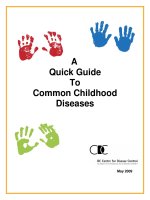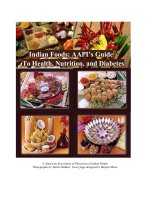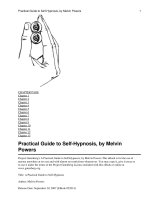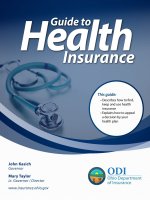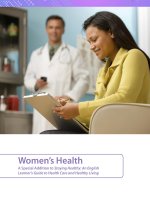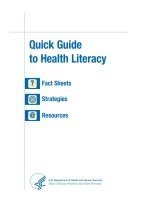Quick Guide to Health Literacy pdf
Bạn đang xem bản rút gọn của tài liệu. Xem và tải ngay bản đầy đủ của tài liệu tại đây (455.64 KB, 36 trang )
U.S. Department of Health and Human Services
Office of Disease Prevention and Health Promotion
?
@
Quick Guide
to Health Literacy
Fact Sheets
Strategies
Resources
U.S. Department of Health and Human Services
Office of Disease Prevention and Health Promotion
Who is the Quick Guide for?
The Quick Guide to Health Literacy is for government employees,
grantees and contractors, and community partners working in healthcare
and public health fields.
It contains:
• A basic overview of key health literacy concepts
• Techniques for improving health literacy through communication,
navigation, knowledge-building, and advocacy
• Examples of health literacy best practices
• Suggestions for addressing health literacy in your organization
These tools can be applied to healthcare delivery, policy, administration,
communication, and education activities aimed at the public. They
also can be incorporated into mission, planning, and evaluation at the
organizational level.
If you are new to health literacy, the Quick Guide will give you the
information you need to become an effective advocate for improved
health literacy. If you are already familiar with the topic, you will find
user-friendly, action-oriented materials that can be easily referenced,
reproduced, and shared with colleagues.
How to use the Quick Guide
The guide is designed to be a quick and easy reference, filled with facts,
definitions, helpful tips, checklists, and resources you can use on the job.
You can print out the materials and keep them at your desk, share them
with colleagues, or bookmark this Web page on your computer.
About This Guide
Quick Guide to Health Literacy
P 1.1
1.2P
The Quick Guide is divided into the following three sections:
1. The first section contains fact sheets on health literacy, including
a basic overview of key concepts and definitions and information
on health literacy and health outcomes.
2. The second section contains practical strategies for improving
health literacy. These include:
• Improve the usability of health information
• Improve the usability of health services
• Build knowledge to improve decisionmaking
• Advocate for health literacy in your organization
3. The final section contains a list of resources, including
Web sites, research studies, and additional publications on
health literacy.
About This Guide
HEALTH LITERACY
U.S. Department of Health and Human Services
Office of Disease Prevention and Health Promotion
What is health literacy?
Health literacy is the degree to which individuals have the capacity to
obtain, process, and understand basic health information and services
needed to make appropriate health decisions.
1
Health literacy is dependent on individual and systemic factors:
• Communication skills of lay persons and professionals
• Lay and professional knowledge of health topics
• Culture
• Demands of the healthcare and public health systems
• Demands of the situation/context
Health literacy affects people’s ability to:
• Navigate the healthcare system, including filling out complex forms
and locating providers and services
• Share personal information, such as health history, with providers
• Engage in self-care and chronic-disease management
• Understand mathematical concepts such as probability and risk
Health literacy includes numeracy skills. For example, calculating
cholesterol and blood sugar levels, measuring medications, and
understanding nutrition labels all require math skills. Choosing between
health plans or comparing prescription drug coverage requires calculating
premiums, copays, and deductibles.
In addition to basic literacy skills, health literacy requires knowledge of
health topics. People with limited health literacy often lack knowledge
or have misinformation about the body as well as the nature and causes
of disease. Without this knowledge, they may not understand the
relationship between lifestyle factors such as diet and exercise and various
health outcomes.
?
Health Literacy Basics
Fact Sheet
P 2.1
2.2P
Health information can overwhelm even persons with advanced literacy
skills. Medical science progresses rapidly. What people may have learned
about health or biology during their school years often becomes outdated
or forgotten, or it is incomplete. Moreover, health information provided in
a stressful or unfamiliar situation is unlikely to be retained.
What is literacy?
Literacy can be defined as a person’s ability to read, write, speak, and
compute and solve problems at levels necessary to:
• Function on the job and in society
• Achieve one’s goals
• Develop one’s knowledge and potential
2
The term “illiteracy” means being unable to read or write. A person who
has limited or low literacy skills is not illiterate.
What is plain language?
Plain language is a strategy for making written and oral information easier to
understand. It is one important tool for improving health literacy.
Plain language is communication that users can understand the first time
they read or hear it. With reasonable time and effort, a plain language
document is one in which people can find what they need, understand what
they find, and act appropriately on that understanding.
3
Key elements of plain language include:
• Organizing your information so that the most important points
come first
• Breaking complex information into understandable chunks
• Using simple language and defining technical terms
• Using the active voice
Language that is plain to one set of readers may not be plain to others.
3
It
is critical to know your audience and have them test your materials before,
during, and after they are developed.
Health Literacy Basics
2.3P
Speaking plainly is just as important as writing plainly. Many plain language
techniques apply to verbal messages, such as avoiding jargon and explaining
technical or medical terms.
What is cultural and linguistic competency?
Culture affects how people communicate, understand, and respond
to health information. Cultural and linguistic competency of health
professionals can contribute to health literacy. Cultural competence is the
ability of health organizations and practitioners to recognize the cultural
beliefs, values, attitudes, traditions, language preferences, and health
practices of diverse populations, and to apply that knowledge to produce a
positive health outcome.
4
Competency includes communicating in a manner
that is linguistically and culturally appropriate.
5
Healthcare professionals have their own culture and language. Many
adopt the “culture of medicine” and the language of their specialty as a
result of their training and work environment. This can affect how health
professionals communicate with the public.
For many individuals with limited English proficiency (LEP), the inability
to communicate in English is the primary barrier to accessing health
information and services. Health information for people with LEP needs
to be communicated plainly in their primary language, using words and
examples that make the information understandable.
Why is health literacy important?
Only 12 percent of adults have Proficient health literacy, according to the
National Assessment of Adult Literacy. In other words, nearly 9 out of 10
adults may lack the skills needed to manage their health and prevent disease.
Fourteen percent of adults (30 million people) have Below Basic health
literacy. These adults were more likely to report their health as poor (42
percent) and are more likely to lack health insurance (28 percent) than
adults with Proficient health literacy.
6
Low literacy has been linked to poor
health outcomes such as higher rates of hospitalization and less frequent
use of preventive services (see Fact Sheet: Health Literacy and Health
Outcomes). Both of these outcomes are associated with higher healthcare
costs.
Health Literacy Basics
2.4P
Who is at risk?
Populations most likely to experience low health literacy are older adults,
racial and ethnic minorities, people with less than a high school degree or
GED certificate, people with low income levels, non-native speakers of
English, and people with compromised health status.
7
Education, language,
culture, access to resources, and age are all factors that affect a person’s
health literacy skills.
Who is responsible for improving health literacy?
The primary responsibility for improving health literacy lies with public
health professionals and the healthcare and public health systems. We
must work together to ensure that health information and services can be
understood and used by all Americans. We must engage in skill building
with healthcare consumers and health professionals. Adult educators can
be productive partners in reaching adults with limited literacy skills.
1
U.S. Department of Health and Human Services. 2000. Healthy People 2010. Washington,
DC: U.S. Government Printing Office. Originally developed for Ratzan SC, Parker RM. 2000.
Introduction. In National Library of Medicine Current Bibliographies in Medicine: Health Literacy.
Selden CR, Zorn M, Ratzan SC, Parker RM, Editors. NLM Pub. No. CBM 2000-1. Bethesda, MD:
National Institutes of Health, U.S. Department of Health and Human Services.
2
Public Law 102-73. The National Literacy Act of 1991.
3
Plain Language Action and Information Network. What is Plain Language? Available at www.
plainlanguage.gov. Accessed on October 21, 2005.
4
U.S. Department of Health and Human Services. 2001. National Standards for Culturally and
Linguistically Appropriate Services in Health Care. Washington, DC: Office of Minority Health.
5
McKinney J, Kurtz-Rossi S. 2000. Culture, Health, and Literacy: A Guide to Health Education
Materials for Adults With Limited English Skills. Boston, MA: World Education.
6
National Center for Education Statistics. 2006. The Health Literacy of America’s Adults: Results
From the 2003 National Assessment of Adult Literacy. Washington, DC: U.S. Department of
Education.
7
Institute of Medicine. 2004. Health Literacy: A Prescription to End Confusion. Washington, DC: The
National Academies Press.
Health Literacy Basics
HEALTH LITERACY
U.S. Department of Health and Human Services
Office of Disease Prevention and Health Promotion
Choosing a healthy lifestyle, knowing how to seek medical care, and taking
advantage of preventive measures require that people understand and use
health information. The ability to obtain, process, and understand health
information needed to make informed health decisions is known
as health literacy.
Given the complexity of the healthcare system, it is not surprising that
limited health literacy is associated with poor health. This fact sheet
summarizes key research study findings on the relationship between health
literacy and health outcomes.
Use of preventive services
According to research studies, persons with limited health literacy
skills are more likely to skip important preventive measures such as
mammograms, Pap smears, and flu shots.
1
When compared to
those with adequate health literacy skills, studies have shown that
patients with limited health literacy skills enter the healthcare system
when they are sicker.
2
Knowledge about medical conditions and treatment
Persons with limited health literacy skills are more likely to have chronic
conditions and are less able to manage them effectively. Studies have
found that patients with high blood pressure,
3
diabetes,
3-5
asthma,
6
or HIV/
AIDS
7-9
who have limited health literacy skills have less knowledge of their
illness and its management.
Rates of hospitalization
Limited health literacy skills are associated with an increase in preventable
hospital visits and admissions.
10-13
Studies have demonstrated a higher
rate of hospitalization and use of emergency services among patients with
limited literacy skills.
12
?
Health Literacy and Health Outcomes
Fact Sheet
P 3.1
3.2P
Health status
Studies demonstrate that persons with limited health literacy skills are
significantly more likely than persons with adequate health literacy skills to
report their health as poor.
10,12,14
Healthcare costs
Persons with limited health literacy skills make greater use of services
designed to treat complications of disease and less use of services
designed to prevent complications.
1,11-13
Studies demonstrate a higher rate
of hospitalization and use of emergency services among patients with limited
health literacy skills.
10-13
This higher use is associated with higher healthcare
costs.
15,16
Stigma and shame
Low health literacy may also have negative psychological effects. One study
found that those with limited health literacy skills reported a sense of shame
about their skill level.
17
As a result, they may hide reading or vocabulary
difficulties to maintain their dignity.
18
Health Literacy and Health Outcomes
About the research
In producing this fact sheet, the Office of Disease Prevention and
Health Promotion relied extensively on both the Institute of Medicine
(2004) and the Agency for Healthcare Research and Quality (2004)
reports, which include comprehensive reviews of the literature on
health literacy and health outcomes. For your convenience, the
original studies are cited.
In these studies, health literacy was measured by the Rapid Estimate
of Adult Literacy in Medicine (REALM) or Test of Functional Health
Literacy in Adults (TOFHLA). Both the IOM and AHRQ reports
conclude that REALM and TOFHLA are assessments of reading ability,
and as such are inadequate measures of health literacy.
Persons with limited health literacy were compared to those
with adequate health literacy. Although an increasing number of
studies have linked limited health literacy to poor health, the causal
relationship between health literacy and health is unknown.
3.3P
1
Scott TL, Gazmararian JA, Williams MV, Baker DW. 2002. Health literacy and preventive health
care use among Medicare enrollees in a managed care organization. Medical Care. 40(5): 395-404.
2
Bennet CL, Ferreira MR, Davis TC, Kaplan J, Weinberger M, Kuzel T, Seday MA, Sartor O.
1998. Relation between literacy, race, and stage of presentation among low-income patients with
prostate cancer. Journal of Clinical Oncology. 16(9): 3101-3104.
3
Williams MV, Baker DW, Parker RM, Nurss JR. 1998. Relationship of functional health literacy
to patients’ knowledge of their chronic disease. A study of patients with hypertension and
diabetes. Archives of Internal Medicine. 158(2): 166-172.
4
Schillinger D, Grumbach K, Piette J, Wang F, Osmond D, Daher C, Palacios J, Sullivan G,
Bindman AB. 2002. Association of health literacy with diabetes outcomes. Journal of the American
Medical Association. 288(4): 475-482.
5
Schillinger D, Grumbach K, Wang F, Wilson C, Daher C, Leong-Grotz K, Castro C, Bindman
AB. 2003. Closing the loop: Physician communication with diabetic patients who have low health
literacy. Archives of Internal Medicine. 163(1): 83-90.
6
Williams MV, Baker DW, Honig EG, Lee TM, Nowlan A. 1998. Inadequate literacy is a barrier
to asthma knowledge and self-care. Chest. 114(4): 1008-1015.
7
Kalichman SC, Ramachandran BB, Catz SP. 1999. Adherence to combination antiretroviral
therapies in HIV patients of low health literacy. Journal of General Internal Medicine. 14(5): 267-273.
8
Kalichman SC, Rompa D. 2000. Functional health literacy is associated with health status and
health-related knowledge in people living with HIV-AIDS. Journal of Acquired Immune Deficiency
Syndromes and Human Retrovirology. 25(4): 337-344.
9
Kalichman SC, Benotsch E, Suarez T, Catz S, Miller J, Rompa D. 2000. Health literacy and
health-related knowledge among persons living with HIV/AIDS. American Journal of Preventive
Medicine. 18(4): 325-331.
10
Baker DW, Parker RM, Williams MV, Clark WS. 1997. The relationship of patient reading ability
to self-reported health and use of health services. American Journal of Public Health. 87(6): 1027-
1030.
11
Baker DW, Parker RM, Williams MV, Clark WS. 1998. Health literacy and the risk of hospital
admission. Journal of General Internal Medicine. 13(12): 791-798.
12
Baker DW, Gazmararian JA, Williams MV, Scott T, Parker RM, Green D, Ren J, Peel J. 2002.
Functional health literacy and the risk of hospital admission among Medicare managed care
enrollees. American Journal of Public Health. 92(8): 1278-1283.
13
Gordon MM, Hampson R, Capell HA, Madhok R. 2002. Illiteracy in rheumatoid arthritis
patients as determined by the Rapid Estimate of Adult Literacy (REALM) score. Rheumatology.
41(7): 750-754.
Health Literacy and Health Outcomes
3.4P
14
National Center for Education Statistics. 2006. The Health Literacy of America’s Adults: Results
From the 2003 National Assessment of Adult Literacy. Washington, DC: U.S. Department of
Education.
15
Friedland R. 1998. New estimates of the high costs of inadequate health literacy. In: Proceedings
of Pfizer Conference “Promoting Health Literacy: A Call to Action.” October 7-8, 1998, Washington,
DC: Pfizer, Inc., 6-10.
16
Howard DH, Gazmararian J, Parker RM. 2005. The impact of low health literacy on the medical
costs of Medicare managed care enrollees. The American Journal of Medicine. 118: 371-377.
17
Parikh NS, Parker RM, Nurss JR, Baker DW, Williams MV. 1996. Shame and health literacy: The
unspoken connection. Patient Education and Counseling. 27(1): 33-39.
18
Baker DW, Parker MR, Williams MV, Ptikin K, Parikh NS, Coates W, Imara M. 1996. The health
care experience of patients with low literacy. Archives of Family Medicine. 5(6): 329-334.
Health Literacy and Health Outcomes
HEALTH LITERACY
U.S. Department of Health and Human Services
Office of Disease Prevention and Health Promotion
Consider the following questions as you develop and deliver health
information:
• Is the information appropriate for the users?
• Is the information easy to use?
• Are you speaking clearly and listening carefully?
Is the information appropriate for the users?
The information below is a summary of best practices in health
communication that can aid in improving health literacy. Many of these
concepts are discussed in depth in the National Cancer Institute’s Making
Health Communication Programs Work (a.k.a. the “Pink Book”) and in the
Centers for Disease Control and Prevention’s tool CDCynergy.
Identify the intended users of the health
information and services.
Identify the intended users based
on epidemiology (who is affected?),
demographics, behavior, culture, and
attitude. This is known as segmentation.
Be sure the materials and messages reflect
the age, social and cultural diversity,
language, and literacy skills of the intended
users. Consider economic contexts,
access to services, and life experiences.
1
Beyond demographics, culture, and
language, consider the communication capacities of the intended users.
Approximately one in six Americans has a communication disorder or
difference resulting in unique challenges.
2
These individuals will require
communication strategies that are tailored to their needs and abilities.
Attention:
These principles also
apply if you are using
existing resources. Be
sure to select materials
that are accurate and
appropriate for the
intended users.
Strategies
Improve the Usability of Health Information
P 4.1
4.2P
Evaluate users’ understanding before, during, and after the
introduction of information and services.
Talk to members of the intended user group before you design your
communication intervention to determine what information they need
to know and how they will use it. Then, pretest messages and services
to get feedback.
Test your messages again, after they have been introduced, to assess
effectiveness. Refine content when necessary. Use a post-test to evaluate
the effectiveness of the information.
Acknowledge cultural differences and practice respect.
Cultural factors include race, ethnicity, language, nationality, religion, age,
gender, sexual orientation, income level, and occupation. Some examples of
attitudes and values that are interrelated with culture include:
• Accepted roles of men and women
• Value of traditional medicine versus Western medicine
• Favorite and forbidden foods
• Manner of dress
• Body language, particularly whether touching or proximity is
permitted in specific situations
1
Ensure that health information is relevant to the intended users’ social and
cultural contexts.
Is the information easy to use?
Limit the number of messages, use plain language, and focus
on action.
3,4
Keep it simple. The number of messages will depend on the information
needs of the intended users. As a general guideline, use no more than
four main messages. Give the user specific actions and recommendations.
Clearly state the actions you want the person to take. Focus on behavior
rather than the underlying medical principles.
Improve the Usability of Health Information
4.3P
Use familiar language and an active voice. Avoid long or run-on sentences.
Organize similar information into several smaller groups.
Many of the same plain language techniques that make the written word
understandable also work with verbal messages, such as avoiding jargon and
using everyday examples to explain technical or medical terms the first time
they are used.
For more information on plain language, visit www.plainlanguage.gov.
Supplement instructions with visuals.
Individual learning styles differ. For many people, visuals are a preferred
style, especially for technical information.
3
Simple line drawings can help
users understand complicated or abstract medical concepts. Make sure
to place images in context. When illustrating internal body parts, for
example, include the outside of the body.
Use visuals that help convey your message.
(Don’t just “decorate,” as this will distract
users.) Make visuals culturally relevant and
use images that are familiar to your audience.
Show the main message on the front of the
materials.
Make written communication look easy to read.
3-5
Use at least 12-point font. Avoid using all capital letters, italics, and fancy
script. Keep line length between 40 and 50 characters. Use headings and
bullets to break up text.
Be sure to leave plenty of white space around the
margins and between sections.
Improve the usability of information
on the Internet.
Studies show that people cannot find the
information they seek on Web sites about 60
percent of the time.
6
This percentage may be
significantly higher for persons with limited
literacy skills.
Improve the Usability of Health Information
For print communication,
use captions or cues to
point out key information.
3
Remember
Refer to the Office
of Management
and Budget (OMB)
Policies for Federal
Public Websites for
further guidance.
4.4P
Many of the elements that improve written and oral communication can be
applied to online information, including using plain language, large font, white
space, and simple graphics.
7
Other elements are specific to the Internet.
These include:
• Enhancing text with video or audio files
• Including interactive features and personalized content
• Using uniform navigation
• Organizing information to minimize searching and scrolling
• Giving users the option to navigate from simple to complex information
A critical way to make information on the Internet more accessible to
persons with limited literacy and health literacy skills is to apply user-
centered design principles and conduct usability testing.
Are you speaking clearly and listening carefully?
Ask open-ended questions.
Ask questions using the words “what” or “how” instead of those that
can be answered with “yes” or “no.” For example, “Tell me about your
problem. What may have caused it?”
3
Try asking “What questions do you
have?” instead of “Do you have any questions?”
Improve the Usability of Health Information
Usability is a measure of several factors that affect a user’s
experience interacting with a product, such as a Web page. These
factors include:
• How fast can the user learn how to use the site?
• How fast can the user accomplish tasks?
• Can the user remember how to use the site the next time he
or she visits?
• How often do users make mistakes?
• How much does the user like the site?
To learn more about usability, visit www.usability.gov.
4.5P
Use a medically trained interpreter.
Plain English will not necessarily help individuals who do not speak English as
their primary language and who have limited ability to speak or understand
English. To better ensure understanding, health information for people
with limited English proficiency needs to be communicated plainly in their
primary language, using words and examples that make the information
relevant to their potentially different cultural norms and values.
Check for understanding.
The “teach-back” method is a technique that healthcare providers and
consumers can use to enhance communication with each other. The
person receiving the health information is asked to restate it in their own
words—not just repeat it—to ensure that the message is understood and
remembered. When understanding is not accurate or complete, the sender
repeats the process until the receiver is able to restate the information
needed.
8
Consumers also can be asked to act out a medication regimen.
3
Participate in plain language and cultural competency training.
Encourage colleagues to do the same. Consider organizing a training for
health professionals and staff in your organization.
Improve the Usability of Health Information
Tip: Checking for understanding
Summarize what the patient needs to do. Consider using a handout or
written brochure in plain language. Explain what each medication is for,
along with the dosage and side effects. Make sure the patient knows where
the information is written down.
Then check for understanding:
“I want to be sure I didn’t leave anything out that I should have told you. Would
you tell me what you are to do so that I can be sure you know what is important?”
(Source: Doak CC, Doak LG, Root JH. 1996. Teaching Patients With Low Literacy Skills. JB
Lippincott Company: Philadelphia, PA.)
4.6P
Improve the Usability of Health Information
U
7>ÃÊÞÕÀÊ>`ÃÊÜÌÊÃ>«Ê>`ÊVi>ÊÜ>ÌiÀ°ÊvÊÞÕÊ`½Ì
>ÛiÊÃ>«Ê>`ÊÜ>ÌiÀ]ÊÞÕÊV>ÊÕÃiÊ>`ÊVi>iÀÃÊÜÌÊ>VÊ
ÊÌi°Ê
U
7>ÃÊÞÕÀÊ>`ÃÊ>ÞÊÌiÃÊi>VÊ`>Þ°Ê
/iÃÊÌÊÜ>ÃÊÞÕÀÊ>`ÃÊ>Ài
",Ê
U
>}Êv`
U
i>Ì}Ê
U
ÌÕV}Ê>ÊÃVÊ«iÀÃÊ
U
ÌÕV}Ê>ÊVÕÌ]ÊÃÀi]ÊÀÊÜÕ`°
/,
U
ÕÃ}ÊÌiÊL>ÌÀÊ
U
LÜ}ÊÞÕÀÊÃi]ÊVÕ}}]ÊÀÊÃiiâ}Ê
U
ÌÕV}ÊÌ}ÃÊÌ>ÌÊ>ÞÊV>ÀÀÞÊ}iÀÃ]Êi
q
`>«iÀÃÊÀÊ>ÊV`ÊÜÊ>ÃÊÕÃi`ÊÌiÊ
ÌiÌ
q
v`ÊÌ>ÌÊÃÊÌÊVi`ÊÀ>ÜÊv`®
q
>>ÃÊÀÊ>>ÊÜ>ÃÌi
q
ÌÀ>ÃÊ
q
Ì}ÃÊÌÕVi`ÊLÞÊyÊ`ÊÜ>ÌiÀ
q
>ÊÃVÊ«iÀÃÊ
q
VÕÌÃ]ÊÃÀiÃ]Ê>`ÊÜÕ`ð
7>ÃÊ9ÕÀÊ>`Ã
vÌiÀÊ>Ê`Ã>ÃÌiÀ]ÊÃÌ>Þ}ÊVi>ÊV>ÊLiÊ>À`ÊÌÊ`°Ê9ÕÊ>ÞÊÌÊ
>ÛiÊÀÕ}ÊÜ>ÌiÀ°ÊÕÌÊÃÌ>Þ}ÊVi>Êi«ÃÊÞÕÊÃÌ>ÞÊi>ÌÞ°
/}ÃÊÞÕÊV>Ê`ÊÌÊÃÌ>ÞÊVi>Ê>`Êi>ÌÞ
,iVi`>ÌÃÊvÀÊÌiÊiÌiÀÃÊvÀÊÃi>ÃiÊÌÀÊ>`Ê*ÀiÛiÌ
Easy-to-read flyer
developed by the Centers
for Disease Control and
Prevention. The flyer
was developed in multiple
languages.
Example:
4.7P
Improve the Usability of Health Information
Checklist for Improving the Usability of
Health Information
o Identify the intended users
o Use pre- and post-tests
o Limit the number of messages
o Use plain language
o Practice respect
o Focus on behavior
o Check for understanding
o Supplement with pictures
o Use a medically trained interpreter or translator
4.8P
1
National Cancer Institute. Making Health Communication Programs Work. Washington, DC.
2
National Institute of Deafness and Other Communication Disorders. Improving Health Literacy.
Available at />3
Doak C, Doak L, Root J. 1996. Teaching Patients With Low Literacy Skills. 2nd Edition. JB Lippincott
Co.: Philadelphia, PA.
4
Plain Language Action and Information Network. Available at www.plainlanguage.gov. Accessed
on October 21, 2005.
5
American Institute for Research. 1981. Guidelines for Document Designers. Washington, DC.
6
U.S. Department of Health and Human Services. Usability Basics. Available at http://www.
usability.gov/basics/index.html. Accessed on October 13, 2005.
7
Baur CE. 2005. Using the Internet To Move Beyond the Brochure and Improve Health Literacy.
In Understanding Health Literacy. Schwartzberg JG, VanGeest JB, Wang CC, Editors. AMA Press,
141-154.
8
Schillinger D, Piette J, Grumbach K, Wang F, Wilson C, Daher C, Leong-Grotz K, Castro C,
Bindman AB. 2003. Closing the loop: Physician communication with diabetic patients who have
low health literacy. Archives of Internal Medicine. 163(1): 83-90.
Improve the Usability of Health Information
HEALTH LITERACY
U.S. Department of Health and Human Services
Office of Disease Prevention and Health Promotion
Navigation of healthcare and public health systems requires being familiar
with the vocabulary, concepts, and processes needed to access health
services and information. This includes understanding insurance coverage
and eligibility for public assistance, filling out patient information forms,
scheduling appointments and follow-up procedures, and locating services.
Strategies to improve the usability of health services include:
• Improve the usability of health forms and instructions
• Improve the accessibility of the physical environment
• Establish a patient navigator program
Improve the usability of health forms and instructions
Healthcare and public health systems rely heavily on printed materials,
including:
• Medical history forms
• Insurance forms
• Informed consent forms
• Patients’ rights and responsibilities
• Test results
• Directions to the lab or pharmacy
• Hospital discharge and home care instructions
• Clinical research protocols and announcements
These documents, particularly forms which contain blank spaces to
be filled in by the user, are often more difficult to understand than
regular prose.
1
Strategies
Improve the Usability of Health Services
P 5.1
5.2P
Consent forms and other legal documents related to patients’ rights often
contain long sentences and difficult legal terms. It is critical that these
forms be translated into plain language. According to recent guidelines
prepared by the National Quality Forum, healthcare providers should ask
each patient to recount what he or she has been told during the informed
consent process to check for understanding.
2
Tips for improving the usability of health forms and
instructions:
• Revise forms to ensure clarity and simplicity.
• Test forms with intended users and revise as needed.
• Provide plain language forms in multiple languages.
• Provide clear information about eligibility for public assistance.
• Train staff to give assistance with completing forms and scheduling
follow-up care.
Sample informed consent language
Voluntary participation:
“You don’t have to be in this research study. You can agree to be
in the study now and change your mind later. Your decision will not
affect your regular care. Your doctor’s attitude toward you will not
change.”
New information about risks:
“We may learn about new things that may make you want to stop
being in the study. If this happens, you will be informed. You can then
decide if you want to continue to be in the study.”
(Source: Paasche-Orlow MK. 2005. The Challenges of Informed Consent for Low-Literate
Populations. In Understanding Health Literacy. Schwartzberg JG, VanGeest JB, Wang CC,
Editors. AMA Press, 119-140.)
Improve the Usability of Health Services
5.3P
Improve accessibility of the physical environment
1
Settings with a large number of signs and postings have a high literacy
demand. Maps, directions, signs, schedules, and instructions are posted
throughout the healthcare setting to help consumers locate services and
information. Many of these signs contain unfamiliar phrases and symbols.
This environment can be intimidating and overwhelming for persons with
limited health literacy skills. Too often, confusing signs and postings create
more work for healthcare staff and cause embarrassment for patients.
Tips for improving the physical
environment:
• Include universal symbols and clear
signage.
• Promote easy flow through healthcare
facilities.
• Train staff to create and maintain a
respectful and shame-free environment.
Establish a patient navigator program
Patient navigators can help consumers access services and appropriate
health information. Patient navigators are health professionals, community
health workers, or highly trained patient liaisons who coordinate health
care for patients and assist them in navigating the healthcare system.
Patient navigators can help patients evaluate their treatment options, obtain
referrals, find clinical trials, and apply for financial assistance.
Hablamos Juntos,
with support from
the Robert Wood
Johnson Foundation,
has developed a set of
Universal Symbols
in Health Care. Visit
www.hablamosjuntos.org
to learn more.
Did you know?
Congress recently passed the Patient Navigator Outreach and Chronic
Disease Prevention Act of 2005. The bill authorizes $25 million in grants
over 5 years to establish patient navigator programs in low-income and
rural communities nationwide.
(Public Law 109-18)
Improve the Usability of Health Services
5.4P
1
Rudd RE, Renzulli D, Pereira A, Daltroy L. 2005. Literacy Demands in Health Care Settings: The
Patient Perspective. In Understanding Health Literacy. Schwartzberg JG, VanGeest JB, Wang CC,
Editors. AMA Press, 69-84.
2
Wu HW, Nishimi RY, Page-Lopez CM, Kizer KW. 2005. Improving Patient Safety Through Informed
Consent for Patients With Limited Health Literacy. National Quality Forum. Available at http://www.
qualityforum.org/docs/informed_consent/webinformedconsentMember+public09-13-05.pdf.
Accessed October 13, 2005.
Improve the Usability of Health Services
HEALTH LITERACY
U.S. Department of Health and Human Services
Office of Disease Prevention and Health Promotion
Build Knowledge to Improve Health Decisionmaking
Being an informed consumer of health information requires more than
reading ability. People with limited health literacy often lack knowledge or
have misinformation about the body and the causes of disease. Without
this knowledge, they may fail to understand the relationship between
lifestyle factors such as diet and exercise and health outcomes. People
with limited health literacy skills may not know when or how to seek care.
Health information can overwhelm even persons with advanced literacy
skills. Medical science progresses rapidly. What people may have learned
about health or biology during their school years often becomes outdated,
forgotten, or is incomplete. Moreover, health information provided in a
stressful or unfamiliar situation is unlikely to be retained.
Strategies to build knowledge and improve health decisionmaking include:
• Improve access to accurate and appropriate health information
• Facilitate healthy decisionmaking
• Partner with educators to improve health curricula
Improve access to accurate and appropriate
health information
Create mechanisms for sharing and distributing plain language
materials among health professionals.
Healthcare and public health professionals can develop plain language
health education materials that can be easily shared among practitioners.
Health education materials should be both scientifically accurate and
culturally appropriate. Develop partnerships among and across regions,
audiences, and fields of interest to facilitate dissemination.
Strategies
P 6.1
6.2P
Health professionals and researchers may want to examine the impact of
participatory action and empowerment research strategies for effective
diffusion of health information at the community level.
1
Work with the media.
Working with the media to improve health literacy involves:
1. Increasing the media’s awareness of health literacy issues.
Many health stories already have a health literacy angle, but it goes
unreported.
2. Making scientific and medical information easier to
understand. Be sure the information you give journalists is
written in plain language and is suitable for a public audience. When
you are working with journalists, emphasize that the provision of
health information, especially when it fosters stress and anxiety in
the public, does not by itself promote public understanding.
Develop new methods for information dissemination.
Health information seeking on the Internet demonstrates the public’s
interest in finding health information someplace other than brochures.
Personal electronic devices (e.g., cell phones, palm pilots) and talking kiosks
could be new methods for delivering health information. Before you create
another brochure, consider whether alternate methods for information
dissemination could improve communication with your intended users.
Message channels
Channels are the routes of message delivery (such as individual, group,
organizational, community, and mass media). Select channels that fit
your communication objectives, your budget, and your timeline.
For more information, refer to CDCynergy.
Build Knowledge to Improve Health Decisionmaking

